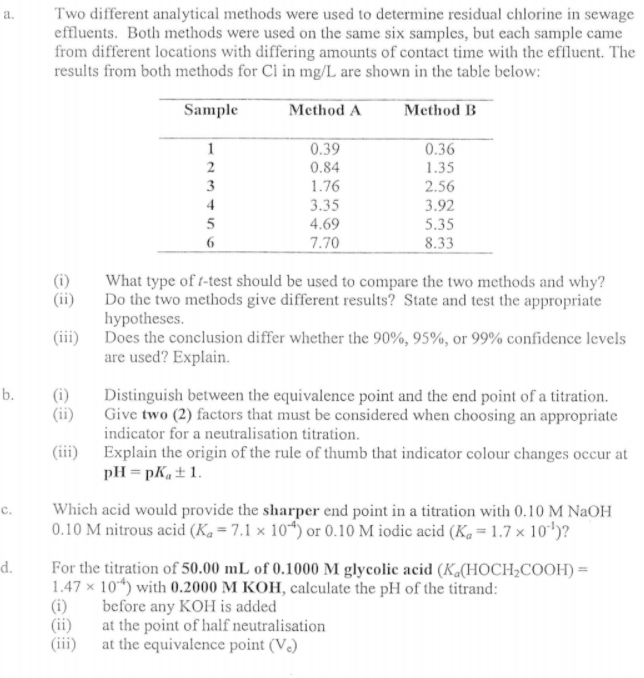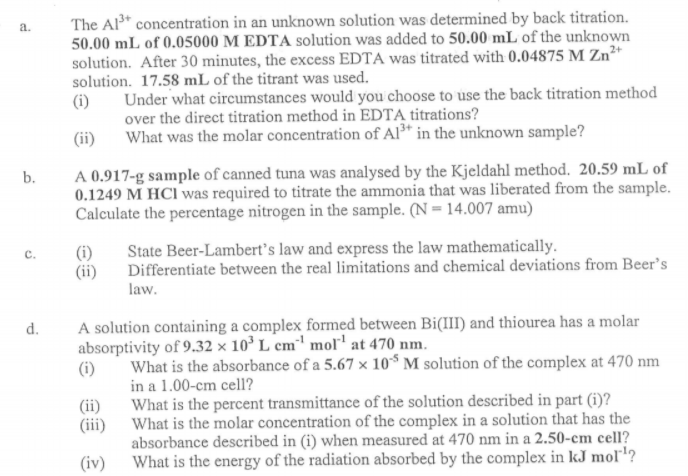Two different analytical methods were used to determine residual chlorine in sewage effluents. Both methods were used on the same six samples, but each sample came from different locations with differing amounts of contact time with the effluent. The results from both methods for Cl in mg/L are shown in the table below: a. Sample Method A Method B 1 0.39 0.36 1.35 2.56 2 0.84 1.76 3.35 4.69 3 4 3.92 5.35 7.70 8.33 What type of t-test should be used to compare the two methods and why? Do the two methods give different results? State and test the appropriate hypotheses. Does the conclusion differ whether the 90%, 95%, or 99% confidence levels are used? Explain. (i) (ii) (iii)
Two different analytical methods were used to determine residual chlorine in sewage effluents. Both methods were used on the same six samples, but each sample came from different locations with differing amounts of contact time with the effluent. The results from both methods for Cl in mg/L are shown in the table below: a. Sample Method A Method B 1 0.39 0.36 1.35 2.56 2 0.84 1.76 3.35 4.69 3 4 3.92 5.35 7.70 8.33 What type of t-test should be used to compare the two methods and why? Do the two methods give different results? State and test the appropriate hypotheses. Does the conclusion differ whether the 90%, 95%, or 99% confidence levels are used? Explain. (i) (ii) (iii)
Principles of Instrumental Analysis
7th Edition
ISBN:9781305577213
Author:Douglas A. Skoog, F. James Holler, Stanley R. Crouch
Publisher:Douglas A. Skoog, F. James Holler, Stanley R. Crouch
ChapterA1: Evaluation Of Analytical Data
Section: Chapter Questions
Problem A1.23QAP
Related questions
Question

Transcribed Image Text:Two different analytical methods were used to determine residual chlorine in sewage
effluents. Both methods were used on the same six samples, but each sample came
from different locations with differing amounts of contact time with the effluent. The
results from both methods for Cl in mg/L are shown in the table below:
a.
Sample
Method A
Method B
1
0.39
0.36
0.84
1.76
1.35
2.56
2
3
4
3.35
3.92
4.69
5.35
7.70
8.33
(i)
(ii)
What type of t-test should be used to compare the two methods and why?
Do the two methods give different results? State and test the appropriate
hypotheses.
(iii) Does the conclusion differ whether the 90%, 95%, or 99% confidence levels
are used? Explain.
Distinguish between the equivalence point and the end point of a titration.
Give two (2) factors that must be considered when choosing an appropriate
indicator for a neutralisation titration.
b.
(i)
(ii)
(iii) Explain the origin of the rule of thumb that indicator colour changes occur at
pH = pK, ±1.
Which acid would provide the sharper end point in a titration with 0.10 M NaOH
0.10 M nitrous acid (K. = 7.1 × 10“) or 0.10 M iodic acid (K, = 1.7 × 10')?
c.
d.
For the titration of 50.00 mL of 0.1000 M glycolic acid (K„(HOCH2COOH) =
1.47 x 10) with 0.2000 M KOH, calculate the pH of the titrand:
(i)
before any KOH is added
(ii)
at the point of half neutralisation
(iii)
at the equivalence point (V.)

Transcribed Image Text:The Al* concentration in an unknown solution was determined by back titration.
50.00 mL of 0.05000 M EDTA solution was added to 50.00 mL of the unknown
solution. After 30 minutes, the excess EDTA was titrated with 0.04875 M Zn²*
solution. 17.58 mL of the titrant was used.
(i)
a.
Under what circumstances would you choose to use the back titration method
over the direct titration method in EDTA titrations?
What was the molar concentration of Al³* in the unknown sample?
(ii)
A 0.917-g sample of canned tuna was analysed by the Kjeldahl method. 20.59 mL of
0.1249 M HCI was required to titrate the ammonia that was liberated from the sample.
Calculate the percentage nitrogen in the sample. (N = 14.007 amu)
b.
(i)
(ii)
State Beer-Lambert’s law and express the law mathematically.
Differentiate between the real limitations and chemical deviations from Beer's
с.
law.
A solution containing a complex formed between Bi(III) and thiourea has a molar
absorptivity of 9.32 × 10° L cm' moľ' at 470 nm.
What is the absorbance of a 5.67 x 10 M solution of the complex at 470 nm
d.
(i)
in a 1.00-cm cell1?
What is the percent transmittance of the solution described in part (i)?
What is the molar concentration of the complex in a solution that has the
absorbance described in (i) when measured at 470 nm in a 2.50-cm cell?
What is the energy of the radiation absorbed by the complex in kJ molr'?
(ii)
(iii)
(iv)
Expert Solution
This question has been solved!
Explore an expertly crafted, step-by-step solution for a thorough understanding of key concepts.
This is a popular solution!
Trending now
This is a popular solution!
Step by step
Solved in 2 steps

Knowledge Booster
Learn more about
Need a deep-dive on the concept behind this application? Look no further. Learn more about this topic, chemistry and related others by exploring similar questions and additional content below.Recommended textbooks for you

Principles of Instrumental Analysis
Chemistry
ISBN:
9781305577213
Author:
Douglas A. Skoog, F. James Holler, Stanley R. Crouch
Publisher:
Cengage Learning


Principles of Instrumental Analysis
Chemistry
ISBN:
9781305577213
Author:
Douglas A. Skoog, F. James Holler, Stanley R. Crouch
Publisher:
Cengage Learning
